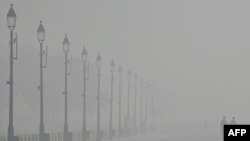Authorities in India's smog-ridden capital, New Delhi, on Sunday extended an emergency schools closure by a week, with no signs of improvement in the megacity's choking levels of pollution.
New Delhi is blanketed in acrid smog every autumn, primarily blamed on stubble burning by farmers in the neighboring agrarian states.
The city is regularly ranked as one of the most polluted on the planet, with its annual smog blamed for hundreds of thousands of premature deaths each year.
"As pollution levels continue to remain high, primary schools in Delhi will stay closed till 10th November," Delhi state's education minister, Atishi, posted on X, formerly known as Twitter.
Secondary schools "are being given the option of shifting to online classes," added Atishi, who uses only one name, after days of high pollution levels.
The Indian capital — which has a population of 30 million — again ranked as the world's most polluted city Sunday, according to monitoring firm IQAir.
Delhi state annually imposes restrictions on construction activities and orders some vehicles off roads when pollution reaches severe levels.
But critics say the government willfully ignores that agricultural processes are the primary source of the public health crisis.
The farmers in neighboring states are a powerful electoral lobby and leaders have long resisted calls to impose strict fines and other punitive measures on them for their actions.
New Delhi is set to host a cricket World Cup match Monday between Sri Lanka and Bangladesh.
But both teams canceled their scheduled pre-match training sessions in recent days over health risks from the smog.
No choice
Bangladesh coach Chandika Hathurusingha admitted Sunday that they have "no choice" but to play.
"We were concerned. We are trying to minimize our exposure to the outdoors as much as possible," he told reporters.
"The air quality is affecting both teams. It's not ideal, but we have no choice. We have to play in the conditions in front of us."
Some asthmatic players had not attended training, he added.
Severe smog levels are expected to persist in the city for several more weeks.
Levels of the most dangerous PM2.5 particles — so tiny they can enter the bloodstream — reached 570 micrograms per cubic meter Sunday according to IQAir, nearly 40 times the daily maximum recommended by the World Health Organization.
A Lancet study in 2020 attributed 1.67 million deaths to air pollution in India during the previous year, including almost 17,500 in New Delhi.
And the average city resident could die nearly 12 years earlier than expected because of air pollution, according to an August report by the University of Chicago's Energy Policy Institute.
India is heavily reliant on polluting coal for energy generation, resisting calls to phase it out, and its per capita coal emissions have risen 29 percent in the past seven years.







